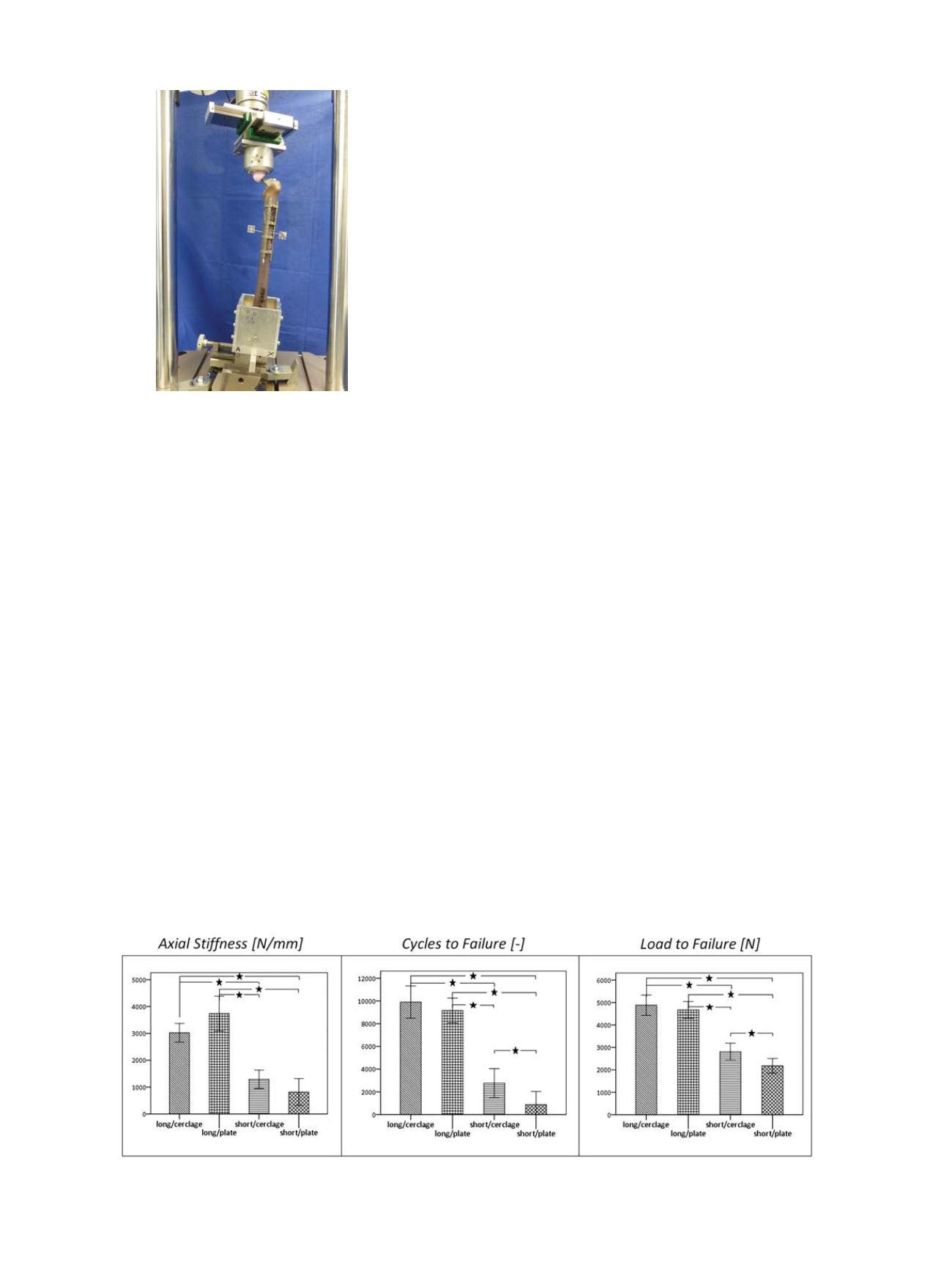

Datawere recordedwith the testingmachine software (WaveMatrix
V1.5, Instron Ltd., High Wycombe, United Kingdom). The movements
in space were calculated with a three dimensional motion analysis
video system (Pontos V6.3, GOM, Braunschweig, Germany), tracking
the markers of the bone fragments. The minimum and maximum load
amplitudes were held for five seconds to take a picture with the Pontos
video system at the beginning of each load step.
The Initial stiffness, cycles to failure, load to failure, the movement
of the stem in relation to the proximal fragment and the relative
motion between the distal and proximal fragment were determined
and statistically analyzed (IBM SPSS Statistics 19, Chicago, IL). Data
acquired by Pontos were matched with the Instron data using
Microsoft Excel (Microsoft Corporation, Redmond, USA) and were
synchronized using a timed trigger. For the statistical analysis, a
univariate analysis of variance (ANOVA) was performed to determine
the influence of the type of stem construct and type of osteosynthesis
separately. In addition, a Student
’
s t-test for independent samples was
executed to identify differences among the four groups. Results are
presented as the mean value ± SD. Significance levels of
p
< 0.05 were
indicated by *.
Results
Static testing revealed that the revision of the short stem with the
long stem caused a 2-fold (
p
< 0.001, ANOVA) increase of axial stiffness.
No consistent effects on axial stiffness were observed when comparing
plating and cerclage wiring (Figure 5). In dynamic testing, the number
of cycles to failure was 4 times higher (
p
< 0.001, ANOVA) with the long
revision stem compared to a short stem. Compared to locked plating
cerclage wiring demonstrated a 26% larger number of cycles to failure
(
p
= 0.031, ANOVA). The analysis of fatigue strength revealed that
the constructs with the long modular stem demonstrated a 91% higher
(
p
< 0.001, ANOVA) load to failure compared to bones with short stems.
Compared to cerclage wiring plating had an 11% smaller load to failure
(
p
< 0.001, ANOVA, Figure 5). Individual differences in static and fatigue
mechanical performance are depicted in Figure 5.
Dislocations of the fragments and the stem were analyzed at 1000
cycles of loading. The relative motion between the distal and proxi-
mal fragment was at least 8 times larger, when a short stem was used
(
p
< 0.001, ANOVA). Similarly the movement after plate fixation was
at least twice as large, than after cerclage wiring (
p
= 0.001, ANOVA).
In contrast, the subsidence of the stem was significantly smaller with
plating, compared to cerclage wiring (
p
= 0.001, ANOVA, Table 1).
Failures of the constructs during cyclic fatigue loading were
characteristically different among the four groups. The long stems
(Figure 6a, b), as well as the short stems in combination with titanium
bands (Figure 6c), failed through an additional fracture in the area of
the tip of the implant. The usage of a short stem and plate showed a
different fracture pattern. Four of those samples broke transversely to
the bone axis and proximal to the tip of the stem (Figure 6d) while one
specimen failed at the most proximal screwof the distal locking screws.
Discussion
The findings of our biomechanical tests on clinically characteristic
spiral Vancouver B1 fractures indicated that osteosynthesis with plate
fixation has no biomechanical advantages over the use of a simple
cerclage system. On the contrary, the cerclage constructs demonstrated
a larger stiffness, larger strength andmore cycles to failure compared to
the plate constructs.
While our findings did not demonstrate any biomechanical
advantages of plate fixation, the review of Pike et al. recommended
the stabilization of B1 fractures with either compression or locking
plates, but not cable-plate devices [13]. Studies performed on
additional cable-stabilizer devices mostly advise against these cable-
plate systems. For example, Tadross et al. suggested based on clinical
findings, that the Dall-Miles Cable system (Stryker Howmedica,
Mahawah, NJ) may not provide sufficient stability on its own [22]. A
further cable plate fixation system, the Odgen Construct, demonstrated
less stiffness than locked plating, but had a similar strength and did
not cause any catastrophic failure, as the locked plating constructs did
[28]. In 2015, Lewis et al. compared synthetic femurs with cemented
THAs and Vancouver B1 fractures fixed with the NCB plate system
against other fixation methods such as a cable plate device and found
that the cable constructs exhibited lower failure forces compared to the
NCB plate system [33].
Fig. 4.
Test setup for cyclic fatigue testing of periprosthetic fracture fixation using a
servo- hydraulic testing machine (Instron 8874, Instron Ltd., High Wycombe, UK).
Fig. 5.
Axial stiffness, cycles to failure and load to failure for the tested groups with different stem/osteosynthesis combinations (Mean value ± 1 SD). *: indicating significant
(
p
< 0.05) differences in the Student
’
s t-test.
K. Gordon et al. / Injury, Int. J. Care Injured 47S2 (2016) S51
–
S57
S54


















